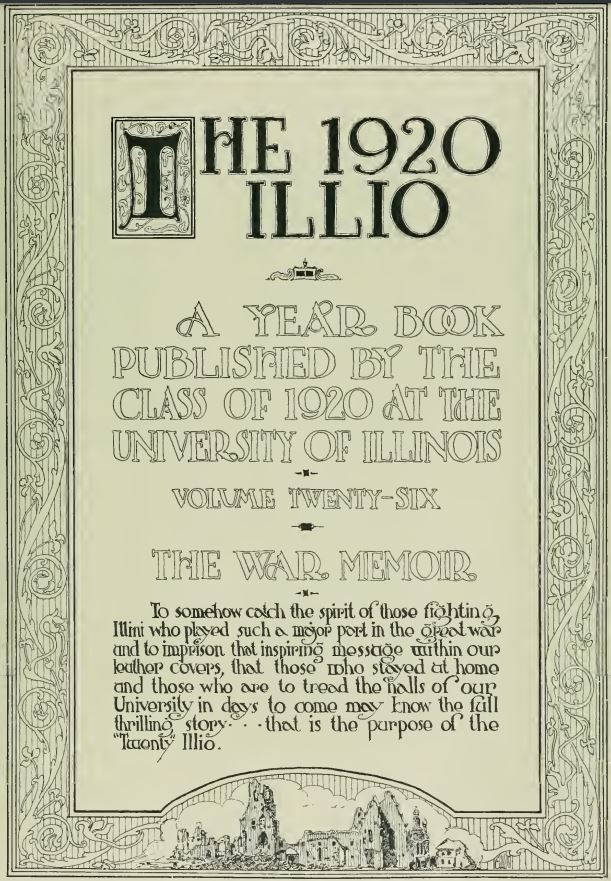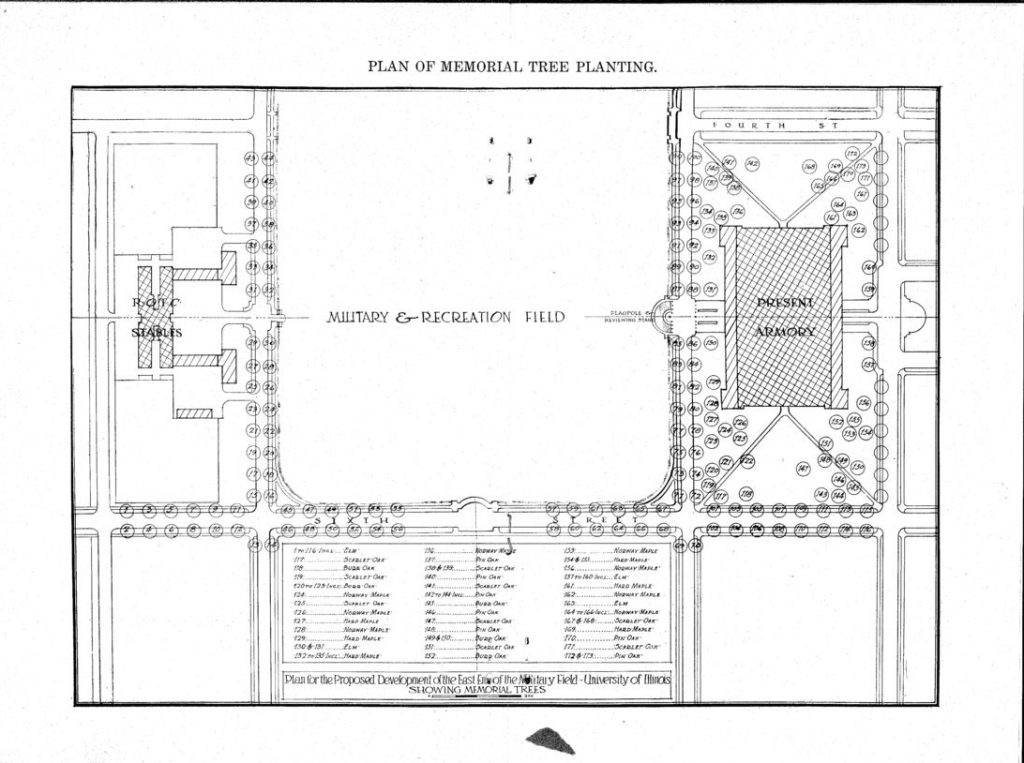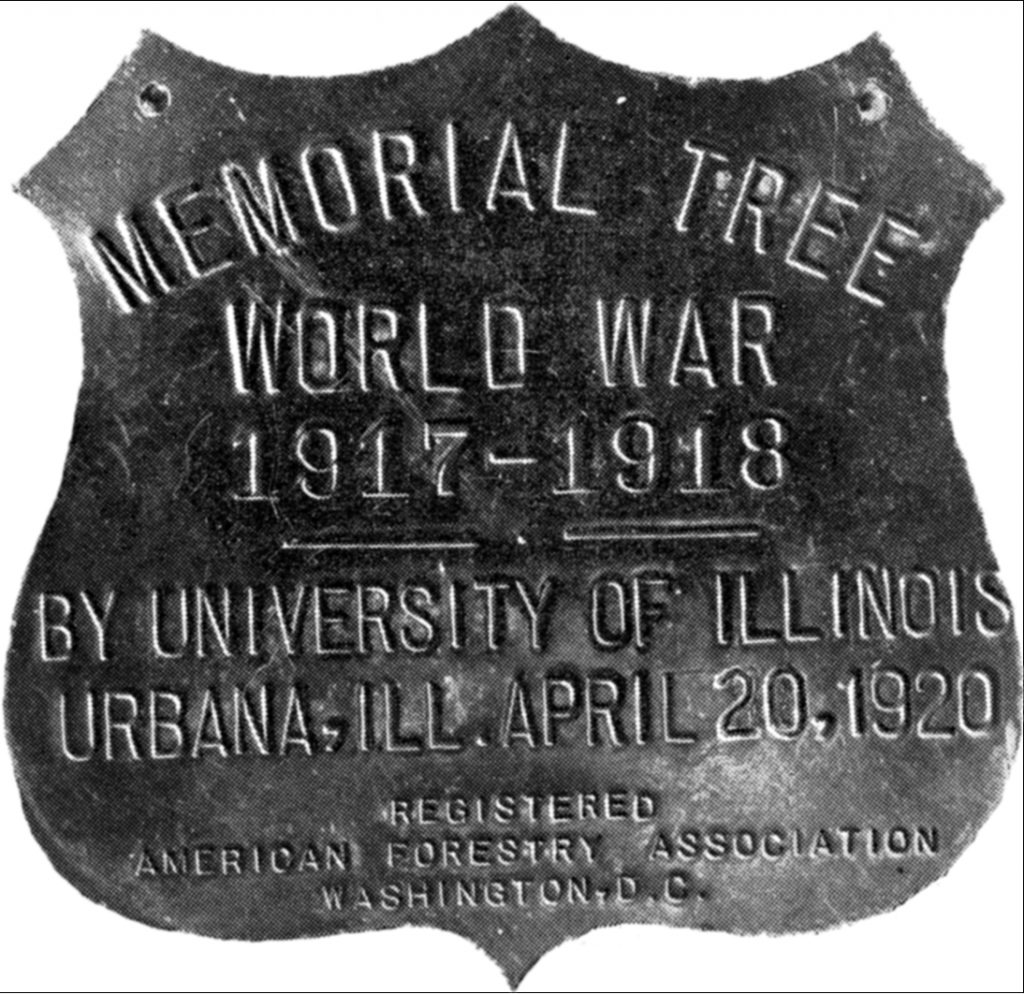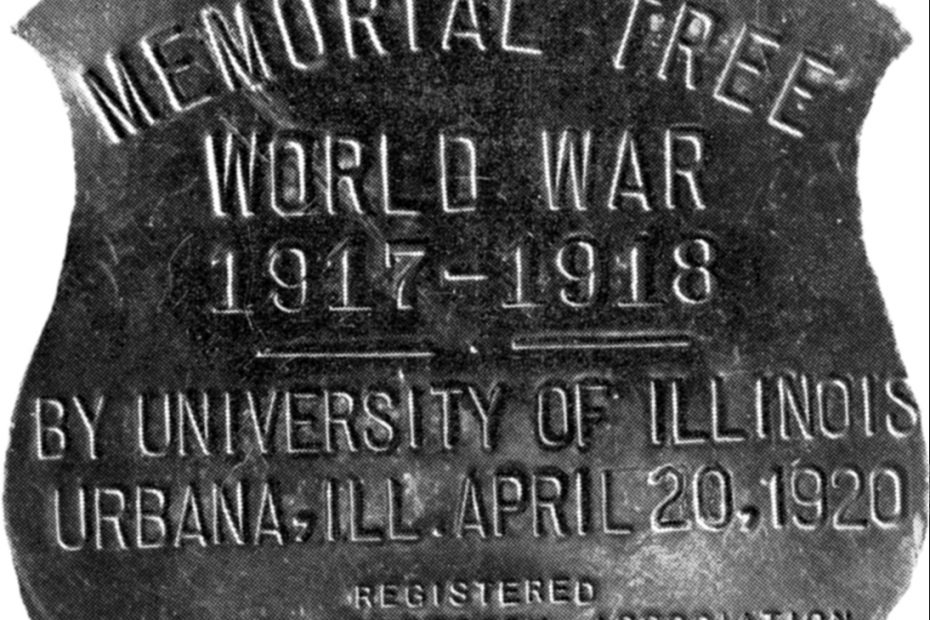World War I Monuments on the Illinois Campus
Following the end of World War I in November 1918, communities across the United States constructed war memorials recognizing local soldiers who made the ultimate sacrifice for their country. According to the Illinois World War I Centennial Committee, more than 5,000 Illinois residents had given their lives in defense of world freedom and liberty during the Great War.
Local communities, including colleges and universities, commemorated their war dead with Soldiers and Sailors monuments, Peace memorials, community buildings, gateways, bell towers, flagpoles, sculpture, parks, playgrounds, gardens, fountains, bridges, tree plantings, stained glass windows, honor rolls, plaques, tablets, and stone monuments. With so many options for war memorials, the University of Illinois quickly established committees who planned, raised funds, and executed both modest and grand war memorial projects on campus. American universities were deeply affected by the loss of students and faculty in the Great War. For instance, at the University of Illinois at Urbana-Champaign, 8,190 men and women were in service by the time the War ended with 1,159 battling in Europe overseas. (The Illio, 1920, p. 2) Back on campus at war’s end, University officials and students searched for a fitting tribute to the 173 Illini who died in service. To this end, some looked to built a grand World War I memorial, while others looked for smaller, but thoughtful remembrances.
Annual Yearbook Becomes a World War I Memoir

One of the first efforts was dedicating the 1920 Illio yearbook to those who served in the Great War. The Illio staff selected images for the annual campus record from over 4,000 war photographs collected from Illini who served. Inside the yearbook, Illio staff marked the year’s events on campus related to World War One, recalled the names of those who died, and inserted recollections of those who served in the Great War. The 1920 Illio remains a resource for how the Great War period of the early 20th-century effected University of Illinois students, staff and administration.
Planting the World War I Tree Living Memorial
After a century, Illini students, alumni, staff and administration may have long forgotten another World War I memorial on campus. The military parade ground, once located to the south of the Armory, has given way to campus buildings. These include George Huff Hall, the Business Instructional Facility and the Siebel Center. In April 1920, the University student body undertook a memorial tree planting program “to keep green the memory of her one hundred and seventy-three sons who gave their lives in the service of their country.” (Memorial Tree Planting Dedication Booklet, April 20, 1920, p. 2) Over 1700 volunteers planted 173 trees for each of the War dead around the Armory and military parade ground from plans by L. D. Tilton, the University’s in-house landscape architect. (“Memorial Fund Drive to Open on Wednesday.” The Daily Illini. March 30, 1920, p. 1.)

After a week of heavy rains, the student union postponed the memorial tree planting and program to April 23, 1920. A military program complete with airplanes, target practice, drill maneuvers and a 21-gun salute, marked the Memorial Tree Planting day. Many relatives and friends heard the names read of the 173 Illini lost at the touching memorial. After planting, the committee marked each tree with an inscription plate. Each marked tree serves as a living reminder to those on campus of the “undying spirit” of those who gave their lives to their country. The American Forestry Association in Washington D.C. registered the memorial trees, and kept a record of the name of each Gold Star Illini for whom the tree was immortalized.

Dean Eugene Davenport of the College of Agriculture presided on behalf of Acting University President David Kinley. He spoke to the memorial crowd about the honor trees:
“The tree, fit emblem of immortality. The seed is lost, merged back into mother earth, even as the bodies of those we loved; but a shaft has risen in its place. It will grow into a mighty column, deep-rooted in the earth. Its leaves will draw perpetual life from the atmosphere and the soil. Its branches will rustle in the summer breezes and its sturdy strength will withstand the storms of every winter. Thus will it typify not only life, but gentleness and strength, even as they typified. And it will bear other seeds for other trees; and this is immortality. And while the campus lasts the young men and maidens will see to it that as these trees age and disappear others shall be put in their places. To the end that as long as the University endures, and while the tribe of Illini lives, these names shall never be forgotten. The University and the state are grateful for this sublime attempt on the part of the students of the University to keep alive the names and deeds of their fallen comrades.”
Dean Eugene Davenport, University of Illinois College of Agriculture, April 23, 1920.
The Lost Armory and Military Parade Ground WWI Tree Memorial
Today, it is unknown exactly how many of the honor trees remain. Living tree memorials are difficult to preserve. Over time, trees succumb to disease, lack of care, or removal in the name of progress. Perhaps it is time to revisit and survey the Armory’s living reminders of the Illini lost in World War I.
As part of the Great War Centennial in 2017, the IIllinois World War I Centennial Committee recognized all memorials across the state with an interactive map and description. Additionally, Landmarks Illinois conducted a survey of World War I monuments. As of November 2021, the database contained more than 300 World War I places. The survey includes seven monuments in Champaign County, and two on the University of Illinois campus. The University’s Armory and Military Parade Ground Tree Memorial was not included in this survey.
University of Illinois Peace Memorial, Inside Lincoln Hall South Courtyard, 702 S Wright, Urbana. 1968 sculpture that once was part of a fountain by Donald Molnar. The University of Illinois classes of 1918 and 1919 commissioned the fountain. University officials removed the fountain and it was reinstalled following the recent Lincoln Hall renovation. For further info on this memorial, see the University of Illinois archives at: https://archives.library.illinois.edu/features/WWIMemorial.php
First Presbyterian Church of Champaign WWI Memorial, 302 W. Church, Champaign
William F. Earnest American Legion Post 559, 704 Hickory St., Champaign
Longview Community Honor Roll, East Logan and Sherman St., SE corner across from post office, Longview
Charles Bowen Busey Memorial, Woodlawn Cemetery, 1803 N. Coler Ave, Urbana
University of Illinois Memorial Stadium, 1402 S. First St., Champaign. Undoubtedly, one of the largest World War I memorials in Illinois.
Copyright © Jennifer Kenny, 2023. No part of this site, www.localarchitecturechicago.com, may be reproduced in whole or in part in any manner without the permission of the copyright owner
Do you need a researcher or a written narrative about historic buildings? Contact Jennifer Kenny, through my web site: https://www.localarchitecturechicago.com
